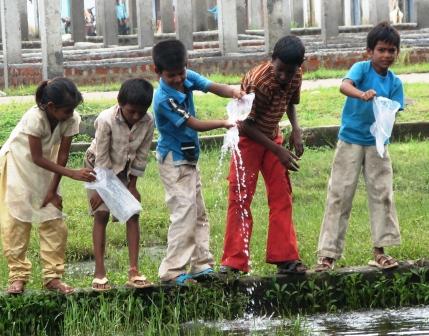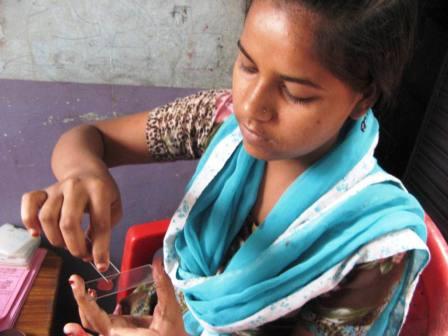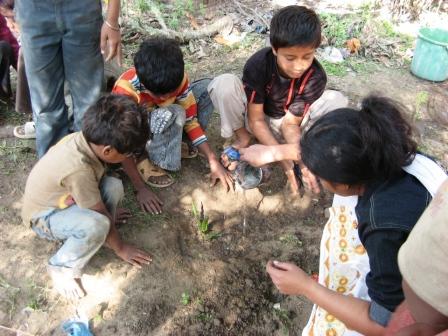Malaria Control through Community Involvement
The programme of malaria control through community involvement was launched by the Sambhavna community healthworkers (CHWs) in 2007. This was in response to the high prevalence of both Vivax and Falciparum malaria in the communities where the Sambhavna CHWs were working. Deaths from Falciparum malaria had also been reported.
Along with the community health volunteers (CHVs) from different communities, the Sambhavna CHWs first carried out health education in small groups in the different communities. The health education materials consisted of simple pamphlets and handmade posters on the causes, prevention, testing and treatment of malaria.
Individuals and families were advised to use neem oil on their bodies to repel mosquitoes and burn neem leaves in the house to drive mosquitoes away. Emphasis was placed on using mosquito nets during the peak mosquito / malaria season in July to October.

 The health education campaigns were followed by collective action in the community led by the CHVs. These consisted of filling up the shallow ditches, pouring waste engine oil or kerosene oil on water bodies and releasing Gambusia fish (obtained from the District Malaria Centre) in ponds and ditches that collect much water in and around the different communities.
The health education campaigns were followed by collective action in the community led by the CHVs. These consisted of filling up the shallow ditches, pouring waste engine oil or kerosene oil on water bodies and releasing Gambusia fish (obtained from the District Malaria Centre) in ponds and ditches that collect much water in and around the different communities.
 The CHWs then shared knowledge on diagnosis and treatment of malaria with the CHVs in different communities and trained them in preparation of blood smear slides for examination under microscope at the Sambhavna pathology laboratory (left). The CHVs were also trained in calculating the dosage of anti-malaria medicines, particularly for child patients. Family members and neighbours of persons with malaria were given prophylactic doses of anti-malarials by the CHVs.
The CHWs then shared knowledge on diagnosis and treatment of malaria with the CHVs in different communities and trained them in preparation of blood smear slides for examination under microscope at the Sambhavna pathology laboratory (left). The CHVs were also trained in calculating the dosage of anti-malaria medicines, particularly for child patients. Family members and neighbours of persons with malaria were given prophylactic doses of anti-malarials by the CHVs.
This programme is continuing in 12 communities (with a total population of 15,000) with the active involvement of 40 CHVs. Sambhavna Clinic data: Programme on malaria control through community involvement.
Growing and using Community Herb Gardens
In 2006, a community herb garden was started around the Oriya Basti informal school set up by the Sambhavna Trust. Following its success and popularity, four herb gardens were started in 2007 in Preet Nagar, Sunder Nagar and Shiv Nagar. However, only one of these four gardens survived the massive floods in 2007.  Three more herb gardens were started in 2009 in Shiv Nagar, Nawab Colony and Navjeevan Colony. However, the garden in Navjeevan Colony did not last long as the CHVs lost interest in its maintenance. Three more herb gardens were started at Sunder Nagar, Shriram Nagar and Shiv Nagar in 2010 and these are doing rather well.
Three more herb gardens were started in 2009 in Shiv Nagar, Nawab Colony and Navjeevan Colony. However, the garden in Navjeevan Colony did not last long as the CHVs lost interest in its maintenance. Three more herb gardens were started at Sunder Nagar, Shriram Nagar and Shiv Nagar in 2010 and these are doing rather well.
| Name of Herb | Communities where planted | Used in treatment of | |
| Local | Latin | ||
| Nirgundi | Vitex nigundo | Nawab Colony, Oriya Basti, Sundar Nagar, Shiv Nagar | Aches and pain |
| Arandi | Ricinus communis | Nawab Colony | Aches and pain |
| Adusa | Adhatoda vasica | Nawab Colony, Shriram Nagar, Oriya Basti, Sundar Nagar, Shiv Nagar | Cough, breathlessness, oral ulcers |
| Sada suhagan | Vinca rosea | Nawab Colony, Shriram Nagar, Sundar Nagar, Shiv Nagar, Oriya Basti | Diabetes, hypertension |
| Gwarpatha | Aloe barbadensis | Nawab Colony, Shriram Nagar, Sundar Nagar, Shiv Nagar | Injuries, excessive vaginal secretions, inflammation and pain, pimples, hair loss |
| Giloy | Tinospora cordifolia | Nawab Colony, Sundar Nagar, Oriya Basti | Fever, muscle pain , pain in limbs |
| Lemon grass | Citronella | Nawab Colony, Shriram Nagar, Shiv Nagar | Cold, insomnia |
| Shatawari | Asparagus racemosus | Nawab Colony, Shriram Nagar, Shiv Nagar, Oriya Basti | Excessive vaginal secretions, weakness, improving lactation |
| Nagdaun | Crinum asiaticum | Shriram Nagar | Piles, boils |
| Tulasi | Ocimum sanctum | Shriram Nagar, Oriya Basti, Sundar Nagar, Shiv Nagar | Cough, breathlessness, oral ulcers, rashes and boils |
| Gudhal | Hibiscus rosa sinensis | Oriya Basti, Sundar Nagar, Shiv Nagar, Nawab Colony | Anemia, excessive vaginal secretions |
| Chiraita | Swertia chirayita | Oriya Basti | Fever |
| Sehajan | Moringa oleifera | Oriya Basti, Sundar Nagar | Anemia, night blindness, oral ulcers |
| Mehendi | Lawsonia inermis | Oriya Basti | Burning in palms and soles of feet, hair loss |
| Anaar | Punica granatum | Oriya Basti | Anemia, diarrhea, dental problems |
| Neem | Nawab Colony, Shriram Nagar, Sundar Nagar, Shiv Nagar, Oriya Basti | Boils, rashes, dental problems, worms | |
| Rose | Sundar Nagar, Shiv Nagar | Anemia, headache | |
The community herb gardens have inspired many residents to grow a few herbs in their homes and use them in cases of common illnesses in their and their neighbour’s families.
The herb gardens are created and looked after by almost all CHVs in the communities named above; 26 CHVs from different communities who have taken training at the herb garden next to the Sambhavna Trust Clinic are fully conversant with the use of the herbs growing in the different community herb gardens.


